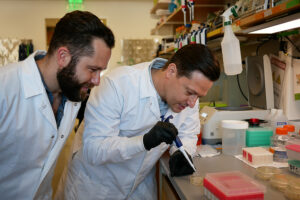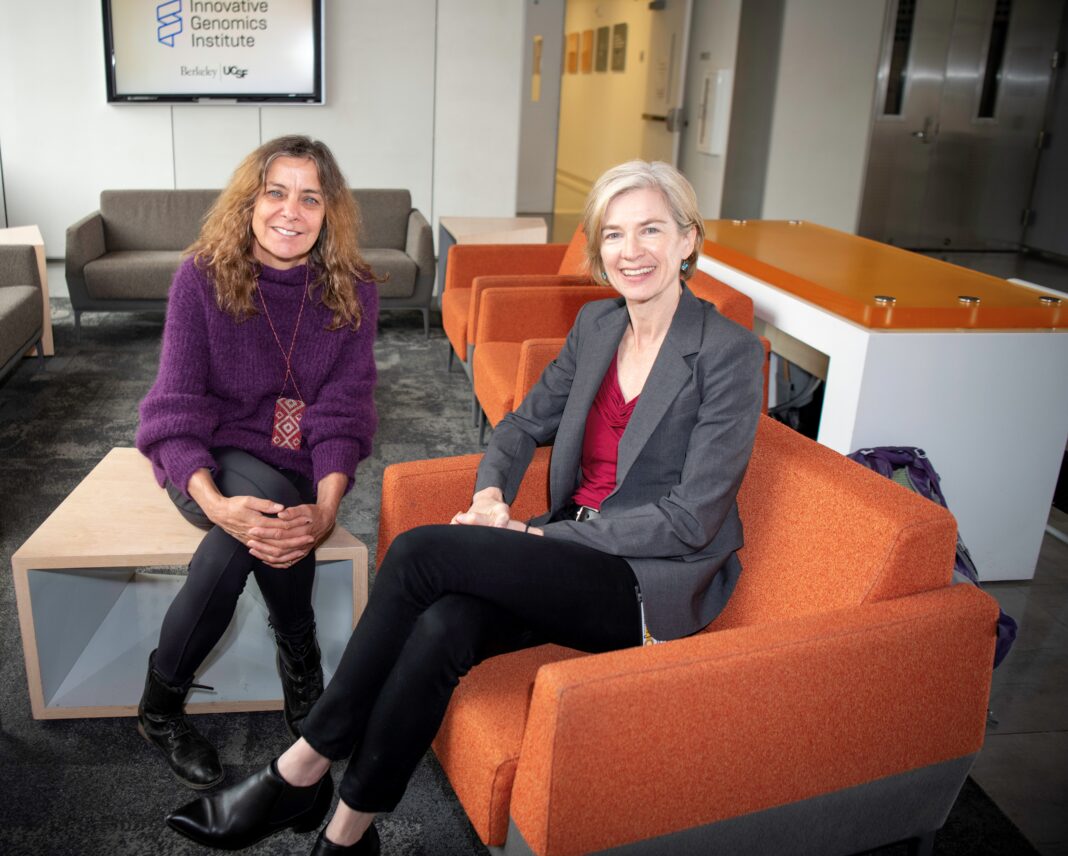A research initiative co-led by Nobel laureate and CRISPR pioneer Jennifer Doudna, PhD, has been awarded $70 million to address health and climate challenges by combining the genome editing technology with genome-resolved metagenomics through the microbiome.
TED’s Audacious Project, a collaborative funding effort designed to help solve grand-scale social impact challenges, will award the $70 million toward “Engineering the Microbiome with CRISPR to Improve our Climate and Health.”
Doudna and Jill Banfield, PhD, both of the Innovative Genomics Institute (IGI) at the University of California (UC), Berkeley, are leading the initiative. It was Banfield who first introduced Doudna to the CRISPR field in bacteria at UC Berkeley’s Free Speech Movement Café in 2006. Banfield pioneered the field of community sequencing or metagenomics, while Doudna shared the 2020 Nobel Prize in Chemistry with her former collaborator, Emmanuelle Charpentier, PhD.
Doudna and Banfield have led a research group that has developed a method of adding or modifying genes within a community of many different species simultaneously, enabling “community editing” of microbes—a technology capable of both editing and tracking edited microbes within a natural community, such as in the gut. The group detailed how they precisely edited genes directly within complex microbiomes, including model systems that replicated natural soil and infant gut microbiomes, in “Species- and site-specific genome editing in complex bacterial communities,” a paper published in January 2022 in Nature Microbiology.
Now, Doudna’s focus on CRISPR and Banfield’s on microbial communities are being combined through the research effort, which aims to apply precision genome editing to microbiomes. The researchers aim to develop a precision microbiome editing platform, and create a new class of products capable of treating and preventing human diseases, as well as reducing greenhouse gas emissions.
“We need to understand microbiomes and there’s a huge knowledge gap even in the simplest microbiomes, such as those that are associated with the human infant and infant calf. We really just don’t understand how they work,” Banfield told GEN Edge. “The power that we are pursuing is to use the editing tools to manipulate organisms in the context of microbial communities, to begin to explore in some detail how organisms interact with each other and how they’re interdependent.”
That approach, she explained, differs from the historic approach to studying microbes growing by themselves, based on pure culture research.
“Our first stage is to begin to explore what functions microbes possess and how they play out. We can do that by using CRISPR-Cas to edit organisms that have not been brought into pure culture,” Banfield continued. “With those tools, we can provide a roadmap or a hypothesis that can be explored in the laboratory, in microbial communities prior to being deployed in actual real-life circumstances.”
Targeting childhood asthma
The IGI—whose priorities include advancing genome engineering to cure disease and advancing food security—will collaborate with two other UC campuses, UC San Francisco (UCSF) and UC Davis. At all three sites, researchers have identified several health challenges they will work on during the seven years of the research initiative.
One challenge is studying whether an inflammatory compound identified by Susan Lynch, PhD, director of the Benioff Center for Microbiome Medicine at UCSF, might be an effective target for treating asthma in children. The compound is produced by gut bacteria in children who develop asthma, and past research by Lynch and colleagues has pinpointed which bacteria produce the greatest concentration of the compound.

Researchers will carry out an extensive analysis of fecal samples collected from children up to two years old to study more potential targets. The research has the potential to be applied beyond asthma, Brad Ringeisen, PhD, IGI’s executive director, told GEN Edge.
“Our approach might be based on the molecule that she’s looked at, and that specific gene and that specific microbe. But it might also be much more expansive. We’re really trying to expand to almost any disease of inflammation,” Ringeisen said.
“We’re really focusing on ways to try to reduce that inflammatory response, which should then reduce the likelihood of developing asthma. But I think it has applications to other diseases of inflammation—things like cardiovascular disease, that are known to be associated with inflammatory markers in the circulatory system as well,” Ringeisen said. “It starts with the characterization of the fecal samples, and then we’ll be able to start going to mice studies, and then ultimately to humans.”
Between the fecal sample characterization and mice studies, Banfield emphasized, the microbial communities will be grown in the lab and tested there.
“One of the three pillars of the initiative is to be able to cultivate realistic human and calf microbiomes in the laboratory, such that they’re stable and representative,” Banfield said. “And then, we can test the editing tools in the context of those communities and also test the consequences of the edits, so we know how the system works in greater resolution before transitioning into organoids, in mice, and ultimately humans or animals.”
Researchers are hoping to expand their studies into calves by year four, then move beyond. If researchers succeed in finding targets, Ringeisen said, “we’re planning to try to start a human trial in year six or year seven.”
Metagenomics and CRISPR
“You can think of the metagenomics component almost as providing a blueprint or a roadmap, and then the CRISPR toolkit being the laser targeted device that’s able to go in and alter either a specific microbe or a specific gene in the microbe,” Ringeisen said. “One doesn’t work without the other. You need both of them combined.”

Over half of human-driven methane emissions are microbial in origin, and the tools needed to deal with problematic microbes at a global scale are lacking or limited: Antibiotics kill both beneficial and harmful bacteria. Probiotics have only shown a limited impact. Fecal transplants have raised concerns over safety and acceptance, though they have shown some promise in specific areas.
Researchers reason, therefore, that animal agriculture is key to addressing greenhouse gas emissions, 15% of which come from livestock, making them a key toward a solution. UC Davis researchers Matthias Hess, PhD, and Ermias Kebreab, PhD, the co-principal investigators heading the livestock methane emissions portion of the research initiative, have focused on dietary interventions aimed at reducing greenhouse gas emissions from livestock.
One such intervention, red seaweed, has led to significant decreases in methane emissions by lowering the expression of methane-producing genes in specific microbes in the cow’s gut.
But providing enough seaweed for daily consumption by the global cattle population—reported at between 942.6 million head (U.S. Department of Agriculture) and 1.5 billion head (World Animal Foundation)—would most likely not work, especially for the grazing cattle that account for most of the world’s livestock. Researchers reason that early intervention with CRISPR, however, could reduce the methane emitted by cows and do so for nearly every calf.
“We’re trying to intervene when the calf is born,” Ringeisen said. “The goal is to use these CRISPR tools and these characterization tools to find a stable microbiome that is a low methane microbiome, and then that that would hopefully set the calf to a lifetime of reduced emissions.”
“Our partners at UC Davis innovated these feed supplements. But now we’re turning their attention to these CRISPR tools and characterization tools to come up with new strategies, which I think are going to ultimately solve the larger problem which the feed supplements can’t.”
Global reach
The research group says it will disseminate the data it collects and the tools it develops to the global research community, and work with global nonprofits to help scale its advances. One global nonprofit the group is working with is the Consortium of International Agricultural Research Centers (CGIAR), a global research partnership with which the researchers have agreed to distribute its technologies to low- and middle-income farmers and ranchers.
Ringeisen said IGI’s public impact team will work to disseminate new technologies developed by the researchers through models that enable companies to profit in the most developed countries but provide the technologies at cost or lower in developing countries.
IGI will soon go public with a task force’s findings on how to broaden access to genomic therapeutics and interventions based on its technologies—and do so affordably. “We’re trying to figure out ways to make these technologies more accessible, so that it can help more people in the world,” Ringeisen said.
Researchers hope to avoid with their technologies the years of legal wrangling that has surrounded the development of CRISPR-Cas9, which has been the subject of a bitter legal battle. Last year, the Patent Trial and Appeal Board (PTAB) of the U.S. Patent and Trademark Office (USPTO) sided against UC, Charpentier, and the University of Vienna, issuing a decision maintaining that the Broad Institute had priority in the invention of a single RNA CRISPR-Cas9 system that functions in eukaryotic cells.
Beyond legal and logistical issues, an even more basic challenge for researchers is much less discovering what microbes exist than it is learning how they interact in community with other organisms.
“We don’t really understand how to read the genome to predict what they’re doing in complete detail,” Banfield acknowledged. “We can predict a lot of the functionalities based on 100 years of laboratory bench work in biochemistry and genetics. But the part that’s minimal and out of view is the set of genes that are involved in interactions with and amongst organisms, because they can’t be probed by pure culture experiments.”
“It’s not so much about discovering new organisms, because we’ve gone through that phase,” Banfield added. “It’s about discovering how they work in the context of their communities, and how that leads to manifestations of disease or undesirable ecosystem impacts such as greenhouse gas emissions.”


